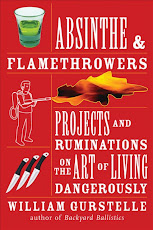Tony Wolf, an expert practitioner of, and a leader in the Bartitsu community sent
me additional information regarding the Bartitsu self defense moves in Absinthe
and Flamethrowers. Much more at www.bartitsu.org
Imagine the case of a man armed with a serviceable stick being
attacked by a skilled boxer. One of the safest and most reliable
methods of defence against a boxer's fists is as follows: --
The man with the stick faces the boxer in the back-guard position --
that is to say, with his left foot and arm extended, and his right arm
guarding his head. His left arm is thus free to guard his face or
body, if, by any chance, he should fail to evade the blow.
As soon as the boxer opens his attack with a direct blow upon the man
with the stick, the latter jumps with one movement to the former's
left, bending well forward in a crouched position, so as to avoid any
possibility of being hit. Then, turning half round on his left toe,
and drawing his right foot in a line with his left, he makes a low,
back-handed sweep with his stick, and strikes the boxer across the
knee, disabling him, and bringing him to the ground.
But for the sake of argument, we will suppose that in the excitement
of the engagement the blow missed the boxer's knee, and struck him on
his shin, in which case he might still be able to show fight. Quickly
recovering his balance, the boxer turns on his left toe by stepping to
the right with his right foot, faces his opponent, and puts in another
blow. But here, again, the man with the stick anticipates the move,
and bayonettes the boxer in the heart before the blow can fall. As his
stick gives him a longer reach than the boxer's, he runs no danger,
and the strong, upward thrust with the stick should completely
incapacitate his adversary.
I should like the reader to thoroughly understand that in every form
of self-defence the first and most essential thing is to have a
well-trained eye. This trick is entirely dependent upon the quickness
of the eye in judging the right moment to jump on one side, so that
the boxer does not become aware of the fact until he has struck at you
and overreached himself, when it is too late for him to make good his
disadvantage.
 Click here to see segment
Click here to see segment







